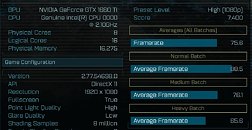
NVIDIA GTX 1660 Ti on February 15th, $279; GTX 1660 in Early March, $229; GTX 1650 in Late March, $179
A report from HardOCP could be shedding a floodlight-like amount of details on NVIDIA's lineup plans for the lower end, and their current generation of Turing videocards. The site, citing industry sources, claims that NVIDIA's GTX 1660 Ti, which has been shown to improve upon NVIDIA's previous-gen GTX 1060 by some 16%, is reported to gon on sale at a previously reported sub-$300 pricing of $279 (lower than the skeptically expected $299). This graphics card is expected to go on sale as early as February 15th.
Other details that shore up information on NVIDIA's plans include the purported early March launch of the slightly slower GTX 1660, which will see its pricing cut down to $229, and the much slower GTX 1650 later on that same month, for $179. Expect performance reviews from your favorite hardware website on the galaxy when those do come out (Commander Shepard would be proud of this endorsement).
Other details that shore up information on NVIDIA's plans include the purported early March launch of the slightly slower GTX 1660, which will see its pricing cut down to $229, and the much slower GTX 1650 later on that same month, for $179. Expect performance reviews from your favorite hardware website on the galaxy when those do come out (Commander Shepard would be proud of this endorsement).


